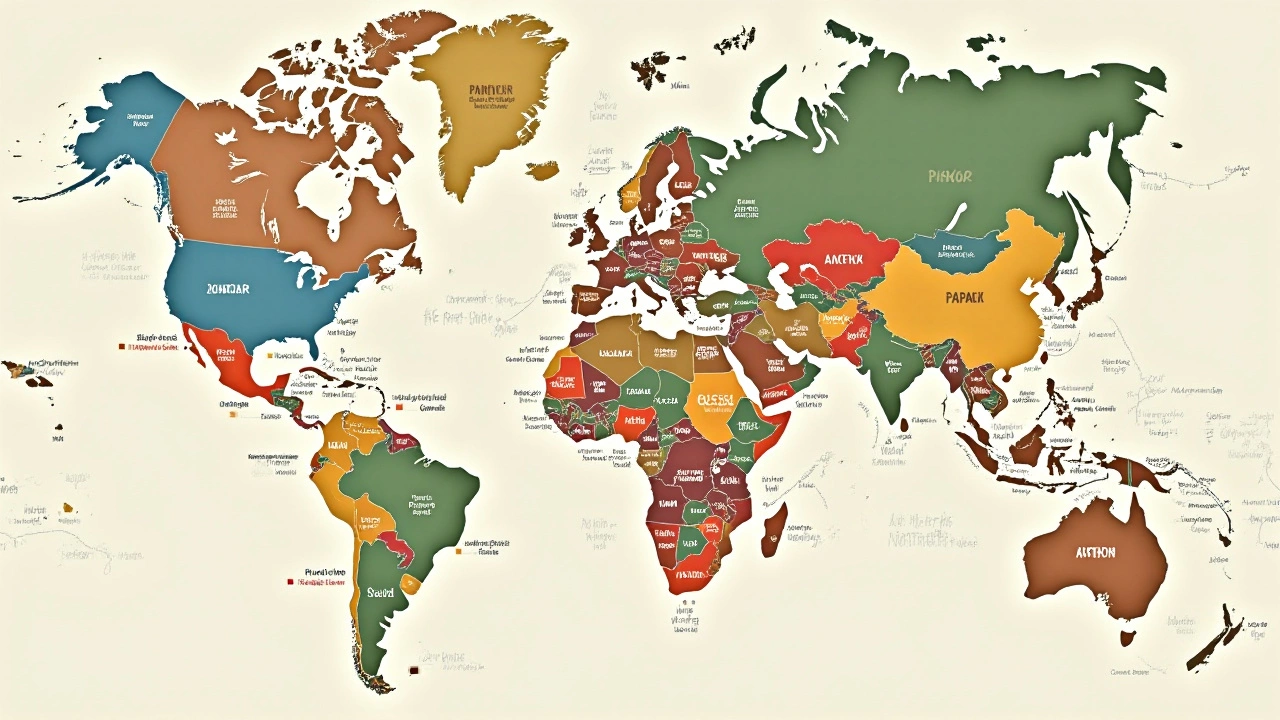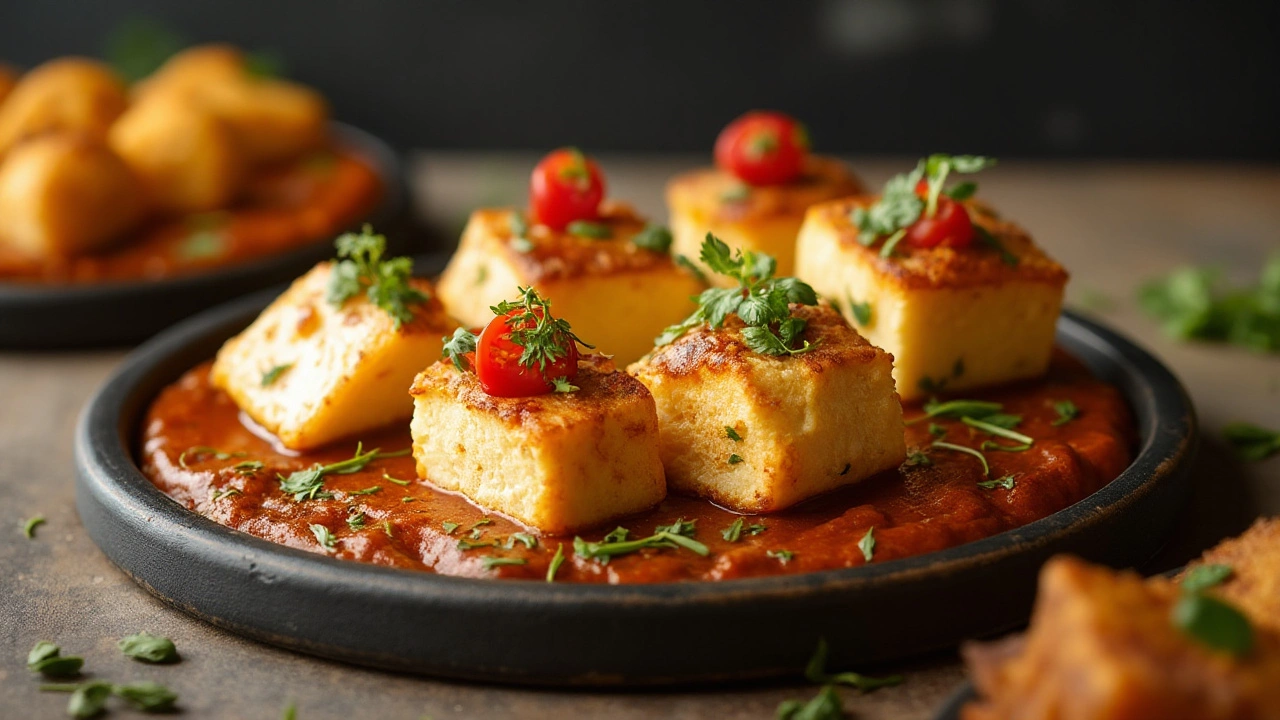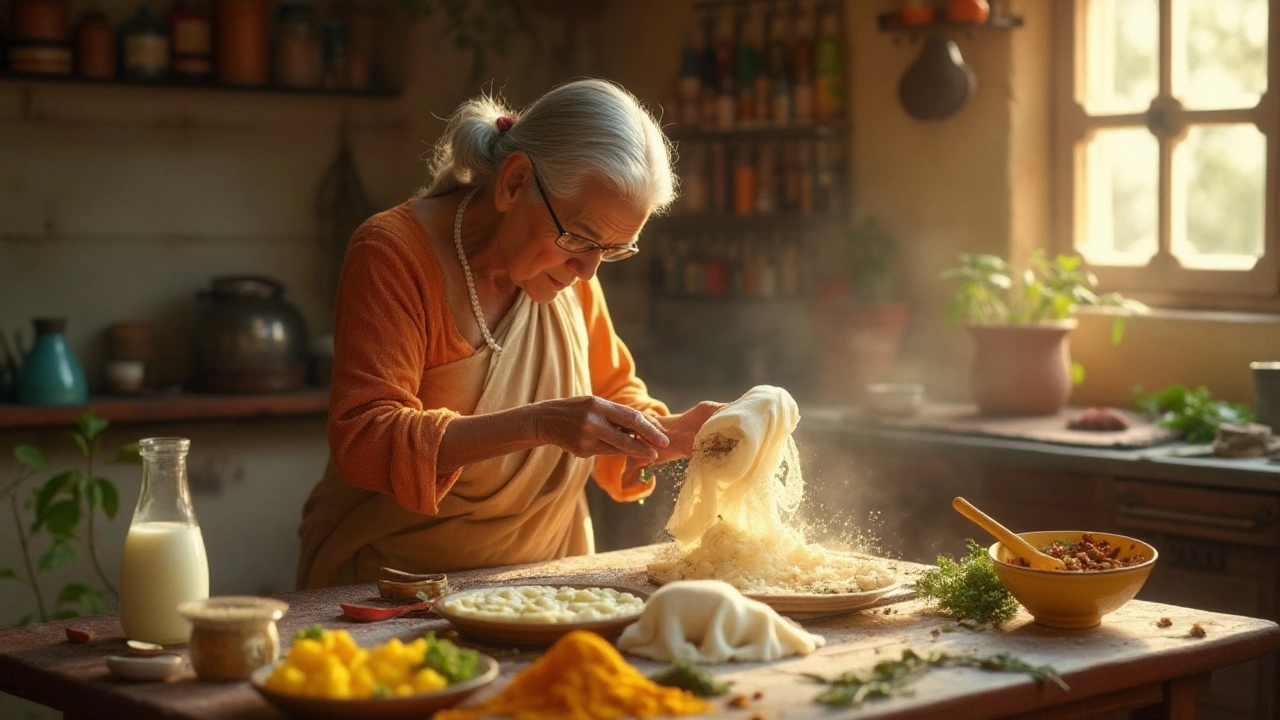Paneer, the unaged, non-melting cheese, is an integral part of Indian cuisine, celebrated for its mild taste and adaptability in diverse dishes. As more food enthusiasts around the world discover its culinary potential, paneer finds itself at the center of a fascinating multicultural discussion. Whether it's called 'farmer's cheese' in the West or 'queso fresco' in parts of Latin America, the labels given to paneer by foreigners provide insight into its global resonance.
This article delves into paneer's journey beyond its traditional borders, shedding light on the various names and interpretations it has acquired. By diving into homemade paneer preparation, we uncover how simple ingredients can create a staple that enhances numerous recipes. Embracing its role in global cuisines, paneer's charm lies in its ability to connect people through shared gastronomy experiences.
- Paneer's Journey Across Cultures
- Different Names for Paneer Worldwide
- Making Homemade Paneer: Tips and Tricks
- Paneer's Role in Global Cuisines
Paneer's Journey Across Cultures
From the vibrant bazaars of New Delhi to the bustling streets of London, paneer has traversed the globe, capturing the hearts and taste buds of countless food enthusiasts. Historically, it is believed that the roots of this beloved cheese can be traced back to the Indian subcontinent, where it has been a culinary star for centuries. Paneer is cherished for its ability to absorb the flavors of the spices and ingredients it is cooked with, making it an essential component of various Indian dishes like palak paneer and butter paneer masala. As the Indian diaspora spread across the world, it carried its rich food traditions, introducing many cultures to the delights of paneer.
The versatility of paneer has inspired chefs and home cooks from different parts of the world to experiment with it in their own cuisines. In the United States, paneer is often likened to homemade cheese, sometimes compared to cottage cheese due to its texture and freshness. It appears on menus from New York to San Francisco, as a key ingredient in fusion dishes, combining traditional recipes with modern twists. Restaurants often use paneer in inventive ways, such as grilled paneer skewers marinated with a blend of local spices, or paneer tacos that marry Indian and Mexican flavors.
In Europe, paneer's journey is just as intriguing. In the UK, home to a significant Indian community, paneer's popularity has soared over the years. It's found in both authentic Indian eateries and contemporary European dining establishments. Meanwhile, in Spain and some parts of Latin America, paneer draws parallels to 'queso fresco,' another type of fresh cheese used in local dishes. While they are distinct, the comparison highlights paneer's adaptability and widespread acceptance across varying culinary landscapes. This cross-cultural exchange enriches each cuisine, offering new dimensions of taste and preparation methods.
"Paneer is indeed more than just cheese; it's a bridge between cultures, a flavorful canvas for creativity," said culinary expert Madhur Jaffrey, emphasizing paneer’s multifaceted appeal.
Recent global food trends have seen a surge in plant-based and vegetarian diets, propelling paneer into the spotlight as a nutrient-rich source of protein for those seeking alternatives to meat. This trend further widens paneer's appeal, attracting those beyond its traditional consumers. The ease of making homemade paneer also contributes to its growing popularity, as people become more inclined to explore homemade, additive-free options. Recipes circulate widely on social media platforms, inspiring cooking enthusiasts to try their hands at crafting paneer in their kitchens, thus multiplying its journey to new culinary realms.

Different Names for Paneer Worldwide
The global journey of paneer has been nothing short of extraordinary, evolving from a staple in Indian households to a cherished element in international kitchens. While exploring diverse culinary landscapes, it's intriguing to observe how distinct cultures have embraced this versatile cheese, each bestowing its own unique name upon it. In the West, paneer is often likened to 'farmer's cheese' due to its similar texture and preparation method, reflecting a shared tradition of crafting fresh, unaged cheeses. This comparison shines a light on the universal appeal of making cheese at home using simple, accessible ingredients.
Across the pond in Latin America, where cheese is a pivotal component of gastronomy, paneer takes on the identity of 'queso fresco.' This term translates to 'fresh cheese' and is a nod to the freshness and mild flavor that are characteristic of traditional paneer. It's a perfect match, given how queso fresco is used in similar ways to paneer, such as for adding depth to salads or serving as a filling in various dishes.
In the Middle East, the connection deepens as paneer is likened to cheeses like halloumi. Though halloumi is known for its grilling capabilities, the similarity lies in the non-melting nature that both types of cheese share. This allows both paneer and halloumi to retain their structure under high heat, making them favorites in salads and grilled meals. A Mediterranean twist on paneer showcases how customs and flavors can transcend borders.
Even within the European culinary scene, paneer has carved out its niche. Countries like Hungary and Romania, known for their rich dairy traditions, refer to paneer-style fresh cheese as 'caș' or 'újkrémsajt,' respectively. These names emphasize both the rich legacy of cheese-making in these regions and the seamless integration of paneer into their culinary repertoire. This integration is quite fascinating when one considers the deeply rooted cheese cultures in these countries.
Paneer's journey to global recognition is a testament to its adaptability and the universal love for cheese. Each name it acquires highlights its role not just as a food, but as a bridge between cultures. In the words of food historian Sherrie Thompson, 'Cheese is a story cooked on low flame,' and paneer's narrative is woven intricately into this tapestry.
Thompson elucidates that 'paneer's rise in global kitchens is not just about taste; it's about embracing the familiar within the foreign,' underscoring the cultural exchange facilitated by this popular cheese.

Making Homemade Paneer: Tips and Tricks
Paneer, the cherished cheese of Indian kitchens, holds a special place with those who relish its unique flavor and texture. Crafting homemade paneer isn't only rewarding; it also allows you to control its freshness and the flavor profile to suit your dishes. The process begins with the simple curdling of milk, typically using an acid such as lemon juice or vinegar. This aspect of Asian culinary art requires attention to detail, ensuring you produce the creamiest, silkiest paneer possible. Fresh whole milk works best because of its higher fat content, which contributes to a rich, creamy result. As you bring the milk to a boil, it's essential to stir it continuously. Random movement prevents it from scorching at the bottom, a small step that protects the paneer's flavor.
Upon reaching a rolling boil, the milk is ready for its transformation. Carefully add the acid, stirring gently as you let the magical concept of curdling take over. The milk will separate into the curds and whey, with the curds forming the basis for your paneer. A piece of cheesecloth will become your ally as you pour this mixture through it, collecting the precious curds. Allowing the whey to drain completely is crucial; excessive moisture can lead to a crumbly texture, which is less desirable if you're planning to cube the cheese for various recipes.
After the whey is drained, gather the cheesecloth and press it gently, forming a solid shape. Stack some weight on top to expel the remaining moisture and give the paneer some character. How long you let it sit will affect its texture, with longer pressing times resulting in a firmer cheese. For those embracing every bit of culinary detail, use the whey for other culinary projects like soups or even baking – a wonderful way to avoid waste.
Once your paneer has set according to your preferred texture, it can be cut into shapes that fit your cooking needs. But before you rush to use it, consider soaking it in some salty brine. This tip elevates the flavor while keeping the paneer soft and inviting in every dish. Whether it's a traditional curry or a fresh salad, the homemade version adds a dimension that store-bought varieties often lack. As noted by prominent Indian chef Sanjeev Kapoor, "Homemade paneer is a celebration of simplicity and flavor."
Letting it marinate in simple spices or fresh herbs before incorporating it into your meal is another way to add depth. When cooking paneer, sear it lightly on high heat, creating a lovely golden crust that enhances its taste wonders. To store any leftovers, refrigerate in an airtight container immersed in water to maintain moisture and freshness. Homemade paneer, with its myriad of uses and variations, offers both culinary satisfaction and an art form, connecting the roots of Indian cuisine with global palates.

Paneer's Role in Global Cuisines
Throughout the culinary world, paneer has evolved from its humble origins in the Indian subcontinent to become a cherished ingredient across diverse cuisines. Known for its soft, creamy texture and mild flavor, paneer easily absorbs the spices and sauces it is cooked with. This adaptability makes it a favorite among chefs looking to create both traditional and innovative dishes alike. In countries like the United States and the United Kingdom, Indian restaurants have popularized paneer by featuring it in a multitude of dishes—from the spicy and robust Paneer Tikka Masala to the rich and buttery Paneer Makhani. These recipes have crossed borders and inspired similar versions in home kitchens around the globe, showcasing paneer's versatility.
In South Asian communities throughout Canada and Australia, paneer serves as an essential protein source for vegetarians, often replacing meat in beloved dishes such as paneer butter masala. As the trend for plant-based diets continues to grow worldwide, more people are discovering paneer as a viable alternative. This shift is evident in the increasing number of Western recipes that incorporate paneer into non-traditional settings, like paneer tacos or paneer-filled pastas, which not only highlight its chameleon-like nature but also its soft yet satisfyingly chewy texture. Seasonal ingredients often accompany paneer, making it a culinary delight in both winter warmers and summer salads.
The reach of paneer doesn't stop at Indian restaurants or vegetarian recipes. In Europe, particularly in cuisines that traditionally feature cheese, paneer has found a new home. Italian chefs have begun experimenting with paneer, using it as a substitute in dishes where fresh cheese might traditionally be used, such as in caprese salads or as an enhancement in risottos. These innovative culinary combinations demonstrate paneer's potential to blend into regional specialties seamlessly. A quote from renowned food critic A.A. Gill might provide additional insight into paneer’s global journey:
"In paneer, we find not just a cheese, but a gateway to uniting the diverse palates of nations through taste."
The adaptability of paneer is highlighted in its crossover into fast casual dining and street food markets in Asia. From quick-serve paneer wraps found in bustling Singaporean food courts to flavorful Karachi street stalls offering paneer-stuffed parathas, its appeal is undeniable. These dishes cater to the fast-paced urban lifestyle, making culinary indulgence accessible even during the busiest of days. Moreover, the textural contrast offered by paneer when deep-fried or grilled adds an intriguing element to snacks like paneer pakoras or kebabs, reflecting the creative ingenuity of street food vendors worldwide.
In conclusion, paneer acts as a binding thread between cultures, whether it’s introducing new flavors into established dishes or serving as a canvas for culinary experimentation. As more food enthusiasts discover the beauty of homemade cheese, the global love affair with paneer will undoubtedly continue to blossom, paving the way for exciting gastronomic experiences. Dave DeWitt, an expert in hot and spicy cuisine, once said:
"The key to great flavor often lies in the unexpected." This rings especially true with paneer, an unassuming cheese that opens doors to flavorful possibilities across continents."
